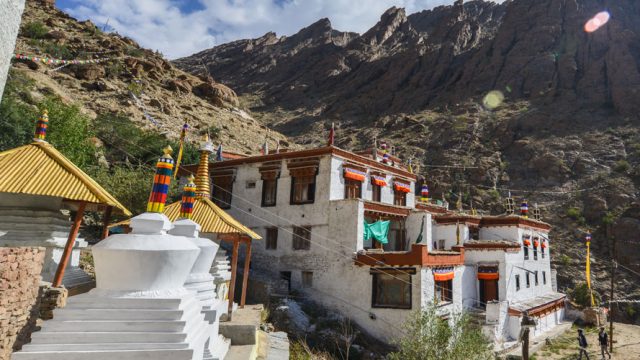The famous Hemis Tsechu, better known as the Hemis Festival, is a major summer festival that celebrates the life and works of the fabulous Guru Padmasambhava. This legendary Indian Buddhist Tantric master, originally hailing from the Swat Valley, is credited with popularising Buddhism across the length and breadth of the Himalaya in the 8th century CE, through his magical, superhuman feats. The dominant Drukpa order of Ladakh, which is a sub-sect of the ancient Kagyupa order of Tibet, venerates Padmasambhava as a second Buddha and celebrates his birthday every year with the masked dance of Chams every year at the Hemis Monastery.

I’d long heard of this festival, and last year I finally had the chance to catch the spectacle. And what a spectacle it was! The Hemis Festival began sometime in the 18th century, and the monastery has been holding its annual celebration every year for over the past 200 years. During the 3-day festivities, there are a number of masked dances performed by Kagyu monks, to celebrate the victory of good over evil, and to consecrate the land with renewed vitality and fertility for the oming year. However, the most important dance is held on the first half of the first day, when, under a huge silk thangka of Gyalsas Rimpoche, masked monks perform a series of dances on Padmasambhava. Every 12 years, on the Monkey Year of the Tibetan Calendar, a special three-stories-high silk thangka depicting Padmasambhava is unfurled. 2016 was a Monkey Year, so I was lucky to see the giant thangka. It was, therefore, an extremely auspicious year, and pilgrims gathered from all over Ladakh and Zanskar, and the huge crowd was swelled by thousands of Indian and foreign tourists from Leh.

I’d reached Hemis at dawn, just in time to see the unfurling of the thangka. However, as the Chams performance was still a few hours away, I had a quick breakfast of tea and biscuits and set out on a small pilgrimage, or a kora, into high, jagged cliffs that rose like immense serrated teeth just behind the monastery. Deep within the folds of those cliffs, about 1,000 feet above Hemis, lay the small hermitage of Kotsang. I stepped out of the monastery and followed a narrow trail, thronging with Ladakhis dressed to the nines, past the last houses of Hemis village and two huge, whitewashed stupas, into the mountains, along the willow-shaded bed of the Hemis stream that flowed down to meet the Indus. There were families of Ladakhis, young friends exchanging watching music videos, old grandfathers dressed in ancient chubas, and girls in stiletto heels, all going up and down the trail, some stopping to catch a breather by the stream. Soon I rounded a bend and the valley curved to the right and opened up. Following a switchback, the trail left the stream and the willows and headed out into the naked rock. Far above, I could see the whitewashed buildings of another, smaller monastery. This was the Kotsang.

The Kotsang was actually a collection of hermitages with individual temples built over small caves. The central temple was built over the largest cave where the founder of the hermitage, a legendary monk called Gyalwa Kotsang, who is said to have meditated here for 12 years. These days, the monks of Hemis continue the tradition, with many retiring to the caves to meditate and perform their tantric sadhanas and austerities for up to 9 years at a time. Some of them had come down to Hemis for the day, and looked markedly different from the other monks. With long hair tied in a ponytail and beards. Many of them looked strikingly like the Padmasambhava image in the thangka. On reaching the Kotsang, I followed the lead of the pilgrims, moving from one temple to another with folded hands, getting blessed by various monks reciting sutras.

The main temple led to the cave, whose walls were adorned with bright images of Buddhas, Bodhisattvas , Siddhas and lineage teachers of the Drukpas, along with various tantric deities and wrathful guardian deities. Unlike the normal donation boxes for pilgrims, here people stuck ten rupee notes and coins to the wall of the cave, before ducking under the yawning black mouth of the cavern to pay their respects to the hand and footprints of Gyalwa Kotsang in the darkest corner of the cave.
After paying my respects at the cave, I continued around the temple, past some of the other shrines where pilgrims were seeking the blessings of presiding monks. Just above the main temple, in a secluded courtyard, pilgrims had gathered for tea and snacks provided by volunteers from Hemis village. While I was sipping my tea, an old man turned to me and started speaking rapidly in Ladakhi. Then he looked up, grinned and said in broken Hindi, “Oh sorry, I thought you were Ladakhi too.” “Don’t too many tourists come up here?” I asked. “Not too many,” he replied, “most don’t even know of this place!”

As I made my way, further up the hill, I came across an open terrace, where families were posing for selfies against the backdrop of the huge valley that we had ascended. One family asked me to take their photos, and then took mine in return. Some others I’d met at the cave also requested that their photos be taken, and I happily obliged, charmed by their warmth and camaraderie.Everyone I met seemed really happy that a ‘tourist’ like me had bothered to make this important kora. I told them that I felt privileged to be here.
While we were chatting, I suddenly heard the deep, booming roar of the long dungchen trumpets from the Hemis monastery, booming up the valley. The performance was about to begin. I said my goodbyes and set off on the long trek back, away from the hidden gem of Kotsang.




